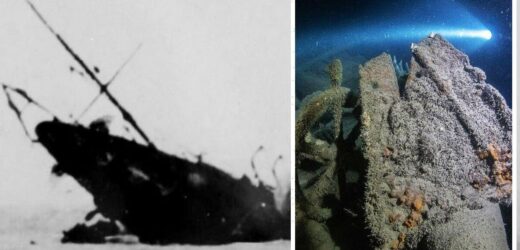Jocelyn Trent says reunited WW1 medals ‘ray of sunshine’
We use your sign-up to provide content in ways you’ve consented to and to improve our understanding of you. This may include adverts from us and 3rd parties based on our understanding. You can unsubscribe at any time. More info
The Navy’s minesweeping gunboat — the HMS Jason — sank off of the coast of Coll, an island in the Inner Hebrides, western Scotland, on April 3, 1917, amid World War 1. Of the vessel’s 91-strong crew, 30 were reported lost in the tragedy, which followed a strike to the ship’s fore by a mine laid by the German submarine U-78 on February 12. HMS Jason is reported to have sank in just five minutes, with her survivors rescued by the fellow minesweeper HMS Circe. Despite the wreck’s location having been listed on nautical charts for decades, a 2011 seabed survey found no trace of the Jason where it was thought to be — resulting in the sunken ship being struck from the records.
Project leader Kevin Heath of SULA Diving said: “It’s been known about in diving circles and shipwreck circles in Scotland for a long time.
“It was one of those mysteries — it was out there, people had looked and couldn’t find it, so I thought I’d take it upon myself to have a look.”
Mr Heath and his colleagues used a surveying technique called side-scan sonar, in which images are created by firing fan-shaped, high-frequency acoustic pulses at the seafloor and measuring the reflected “backscatter”.
Following five years of investigation, the team found the wreck of the 243-foot-long vessel lying some 0.37 miles from where it was thought to have sank, lying next to a large rock at a depth of around 305 feet.


Divers were able to confirm the presence of the wreck after sailing out to the site on the MV Clasina on April 12 — with the vessel sporting several identifying features including a pointed stern, distinctive starboard propeller and two 4.7 inch guns.
The marine archaeologists also found assorted artefacts down in the wreck, including plates and bottles, two telegraphs, the helm and a compass.
Mr Heath said: “It’s been there since World War One so it’s very broken down.
“But it’s upright, with a slight list to port, the aft gun is there, then all of the machinery is exposed, then there’s the bridge, then there’s a forward gun.
“And just at the forward gun, there is a break where the wreckage is missing and that’s where she hit the mine.”
HMS Jason was built as an Alarm-class torpedo gunboat between 1891–1893, but was retrofitted for service as a minesweeper in 1909, a role that she continued into World War 1.


Royal Navy Lieutenant Jen Smith, who was part of the dive team, said the discovery was “incredibly moving”.
She added: “There was excitement at finding the wreck, but that’s quickly tempered by the fact that it’s a war grave — men died here.
“It’s incredibly moving to think that no one has seen the ship since her stern disappeared 105 years ago.
“Families knew the fate of the ship, but now they will know where she is and that can bring closure.”
DON’T MISS:
UK embarrassment laid bare: US hid details of NUKING British satellite [REPORT]
Russia’s ‘only oil pipeline to EU’ in flames – 3 countries face crisis [INSIGHT]
Forget Satan 2! US £157bn project can wipe out Putin’s missile [ANALYSIS]

Lt Smith added: “Documenting the ship — showing people what she’s like today — is important to me.
“Naval war graves are often forgotten, as it’s hard for people to remember what you can’t see.
“Whilst land battlefields and cemeteries such as those in Normandy or the Somme can be visited by anyone, only a few of us can visit a shipwreck.
“So the more we can show and explain what happened to her and her sailors, the better. It’s important to make sure those who served are not forgotten.”
Dive group leader Steve Mortimer, also of SULA Diving, said: “It was a privilege to help identify the remains of this vessel.”
The families of those lost in the accident, he added, “can now take comfort that the location of their relatives’ ship is precisely known. We think that’s important.”
With HMS Jason now located, the researchers are moving to ensure that the wreck is protected from interference under law as an official war grave.
Mr Heath has collaborated with historian Wendy Sadler to document the story of HMS Jason and her crew on the website lostinwatersdeep.co.uk.
Additional reporting by Michael Havis.
Source: Read Full Article

